Thank you for your patience, dear subscribers, while I suffered through computer chaos. All is well now, thanks to the kindly geniuses at Necessary Technology in Portland, Maine—and to my foresight in paying for an Apple warranty. I had 96 days left on the warranty when Arabella decided it was time for a little R&R. Two weeks later, all is forgiven and she’s home again.
Now, why not welcome me and Arabella back by hitting that little heart up there in the lefthand corner to reassure us that you do “like” us? I feel I owe you all a lot and will scramble to provide plenty of new content, new ideas, new thoughts, to make up for two-plus weeks of absence.
Incredibly, it’s already August and summer days are rapidly waning. That sparkling patchwork mosaic of brilliantly varied greens, from lawns, fields, gardens, woodlots and forests that so delighted us in June has blended, some might say blanded, and matured into a more uniform tone. The green is still there, brightening in the sunlight, dulling in shade, but it has lost its dazzle and settled into the lazy somnolence of August afternoons, too hot to stir, too hot for anything but a tall glass of iced tea and maybe a blueberry tart?
Any day now, the big yellow school buses will start making their practice runs--and more and more of them are running on electricity these days, for which they are to be heartily congratulated. (Q: In this time of computed everything, do kids still get new pencil cases in their back-to-school kit?) The crickets are creaking, milkweed bursts its pods, sumac darkens to a rich mahogany color while goldenrod blossoms along the roadsides (and the Kleenex box on my desk quickly empties as I sneeze and sniffle); on farm stands tomatoes glow—red, yellow, orange, golden, pink, deep dark purple—and corn cobs are fat on their stalks, apples are beginning to blush, soon to be ready for that first, crisp, deeply satisfying bite, the harvest cornucopias are full, and blueberries are prolific.
Not just any blueberries, of course, but Maine wild (low-bush) blueberries, truly the finest kind, small, sweet, packed with complex flavor as well as with valuable antioxidants to keep you healthy and wise. Maine wild blueberries, according to a number of peer-reviewed publications including the USDA data base, have one of the highest antioxidant contents of any fruits or vegetables. The density of antioxidants, which is reflected in the flavor, is a direct result of genetic diversity. Dave Yarborough, a blueberry specialist and emeritus professor at the University of Maine in Orono, explained to me why that is: a blueberry barren—that’s the terrain in which wild blueberries thrive--is rocky, thin, acid-soiled, and as bleakly beautiful as a Yorkshire moor; it "consists of thousands of genetically diverse plants,” Dave told me. “Because of the diversity, they ripen at different times. So you get a certain amount of overripe and underripe fruit along with fruit that’s perfectly mature, and this adds to the complexity.”
Do you remember Robert McCloskey’s captivating children’s book Blueberries for Sal? That story, first published back in 1948, is practically a folk myth in Maine
where harvesting blueberries together under the late summer sun is a treasured family activity. There are dozens of family recipes for turning this cherished little fruit into muffins, pies, tortes, pancakes, crisps, slumps, grunts, and cobblers, plus blueberry jam and frozen berries to top wintertime oatmeal (along with the maple syrup that we made in Maine last March).
Maine wild blueberries, I will confess, are not truly wild but rather what’s called a managed crop. Calling them ”wild” blueberries is actually no more accurate than calling Maine lobster ”wild.” In both cases, the product emerges from the wild and reproduces in the wild, but the guiding hand of humans coaxes the wild stock to fruition and proliferation through careful but minimal cultivation. Bear in mind that these wild low-bush blues have something like twice the antioxidant content of cultivated high-bush blueberries, the fat berries you will perhaps find most readily in your supermarket produce section.
Most of Maine’s blueberries are frozen for national distribution, although in the midst of harvest here in their homeland, we wouldn’t dream of using anything but fresh fruit, preferably warmed by the sun and gathered by hand. I asked Dave Yarborough if the antioxidant content is affected by cooking. ”It is a little,” he said, ”but that’s just a good excuse for two pieces of pie.”
Here’s a start with recipes for wild blueberry muffins and the famous North Haven wild blueberry tart. And yes, you can make these with cultivated, high-bush blueberries, though they never have the same intensity of flavor as the wild one. I’ll publish a few more recipes in the days to come, but this beginning is for all subscribers, paid or not, as a reward for your patience.
Maine Wild Blueberry Muffins
These are classic, old-fashioned muffins, perfect for a hearty, back-to-school breakfast, the kind my grandmother would have made if she had ever made muffins. (She died when I was six so I don’t remember her muffins or much of anything else, alas.) They are not very sweet, not like those humongous, cakey, sugary confections that are customarily called muffins in delis in New York City, and perhaps elsewhere too.
Speaking of breakfast, you can get a head start on this the night before: mix up the dry ingredients and butter the muffin cups. Combine the eggs, milk, and vanilla, and set in the refrigerator or a cool pantry. Then in the morning, set the oven to 425º and while it’s heating, melt the butter, combine with the egg-milk mixture, stir into the dry ingredients and add the blueberries. Then spoon into the prepared muffin cups and away you go—hot muffins for breakfast!
Makes about a dozen muffins.
About 6 tablespoons unsalted butter plus a little more to grease the
muffin cups
2 cups unbleached all-purpose flour (or use half whole-wheat flour)
Pinch of sea salt
2 teaspoons baking powder
¼ cup sugar
2 eggs
¾ cup milk
1 teaspoon pure vanilla extract
1 teaspoon grated lemon zest
2 cups Maine wild blueberries
Turbinado sugar mixed with ground cinnamon to sprinkle on top (optional)
Set the oven at 425 degrees. Grease the muffin cups with a little butter and set 6 tablespoons of butter to melt in a small pan over very low heat.
In a mixing bowl, toss together the flour, salt, baking powder, and sugar. Use about 3 tablespoons of this to sprinkle over the blueberries in a separate bowl, tossing the berries to coat with the flour. This should keep the berries from falling to the bottom of the muffin tins.
Whisk the eggs and milk together, then whisk in the melted butter. Add the lemon zest and vanilla and whisk to combine.
Make a well in the dry ingredients and pour in the egg mixture. Stir the dry ingredients into the egg mixture, using a fork, just until moistened. Don’t aim for a smooth batter--that will yield tough, grainy muffins. Finally, using a rubber spatula, fold in the floured blueberries, mixing just enough to distribute them throughout the batter.
Fill each muffin cup about two-thirds full. If you wish to add a final fillip, you could mix about half a teaspoon of ground cinnamon with 3 teaspoons turbinado sugar and sprinkle a little of this on the top of each muffin.
Transfer to the hot oven and bake 20 to 25 minutes, or until muffins are brown and pull away from the sides of the tin. Remove from the oven and let them cool in the tin on a rack for about 10 minutes—this is important, don’t rush it--then run a knife gently around the sides of each muffin, tip them onto a rack, and serve immediately.
North Haven Wild Blueberry Tart
To make a pie to serve 8 (or possibly 9), you’ll need:
1 cup (240 ml) old-fashioned rolled oats
¼ cup (60 ml) coarsely chopped walnuts
1 ¾ sticks (7 ounces/200 grams) of unsalted butter
About 2/3 cup (150 ml.) sugar
1 teaspoon pure vanilla extract
Pinch of salt
Pinch of ground cinnamon
1 ¼ cups (300 ml) flour
3 1/2 to 4 cups (1 scant quart or liter) Maine wild blueberries or cultivated high-bush blueberries, rinsed in a colander and shaken dry
Grated zest of 1 small lemon
1 or 2 tablespoons cornstarch
Combine the rolled oats and chopped walnuts in the bowl of a food processor and process, pulsing, to make a grainy, crumby mixture. Set aside.
In a mixing bowl, blend together the butter and ½ cup (125 ml.) of sugar and beat with a hand mixer until it is very fluffy. Beat in the vanilla, salt, and cinnamon. Add the flour with the oats and walnuts, and mix together well, using a rubber spatula or your hands to combine and knead gently. Shape into a flat disk, wrap in plastic wrap, and set in the refrigerator for at least 30 minutes. You could also make this ahead and refrigerate overnight.
When you’re ready to prepare the tart, remove the dough from the fridge and let it warm slightly so it’s easier to manipulate. Gently press the dough into a 10-inch (25 cm.) fluted tart pan (preferably one with a removable bottom), thoroughly covering the bottom and sides with a thin layer of dough. (Think of a cookie crust or a graham cracker crust; it’s the same idea.) Trim the top so it’s level with the top of the tart pan and use any extra bits to patch holes in the crust. Prick with a fork in several places over the bottom, then wrap the pan in plastic wrap and set it in the freezer for at least 30 minutes.
While the dough is chilling, set the oven on 400ºF./200ºC. After the dough is chilled (and you could leave it for longer if necessary, as long as it doesn’t dry out), take the pan from the freezer, unwrap it, and transfer it to the hot oven. Bake 15 to 20 minutes or until the crust is lightly golden.
Remove the pan and, using a dish towel to protect your knuckles, gently press the dough crust, which will have risen a bit, back into the pan.
Now make the berry filling. There are two ways to do this:
A) In a small pot, combine the remaining sugar with about 1 ½ cups of the berries and the lemon zest. Set over low heat and cook, stirring, until the sugar has melted, then raise the heat a little higher, add a tablespoon of cornstarch, and cook at a boil, stirring to blend the cornstarch in, until the berries thicken to a jammy texture--about 6 to 8 minutes. Once the berries have thickened, remove them from the heat and let them cool down a bit, then stir into the uncooked berries, mixing vigorously with a fork, just enough to bruise some of them lightly.
B) For a fresher flavor, and especially if you have Maine wild blueberries, combine the berries with the lemon zest, cornstarch and the remaining sugar. Toss the berries vigorously with a fork, just enough to bruise some of them lightly which will start the juices flowing when they’re heated.
The oven should be set on 400ºF/200ºC.
Turn the contents of the bowl into the pie crust. If the top edge of the crust is already brown, set a protective ring on it—or cover it with a piece of aluminum foil—to keep it from getting too dark. Transfer the tart pan to the oven and bake for about 25 minutes.
Remove the tart from the oven when it’s done and set aside to settle before slicing it to serve. Serve the tart as is, or better yet, top it with a spoonful of whipped cream or plain vanilla ice cream.
Cook’s tip: As an extra fillip, melt about 1/4 cup of apple or red currant jelly in a saucepan and when the tart is cooled to room temperature spoon the jelly over the berries to make a light glaze. Refrigerate for at least 15 minutes before serving.

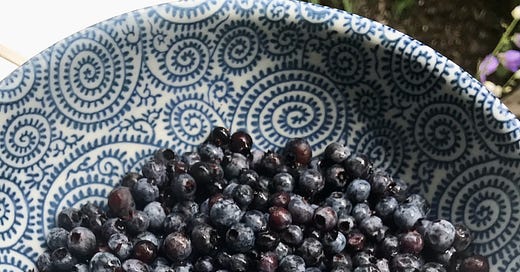



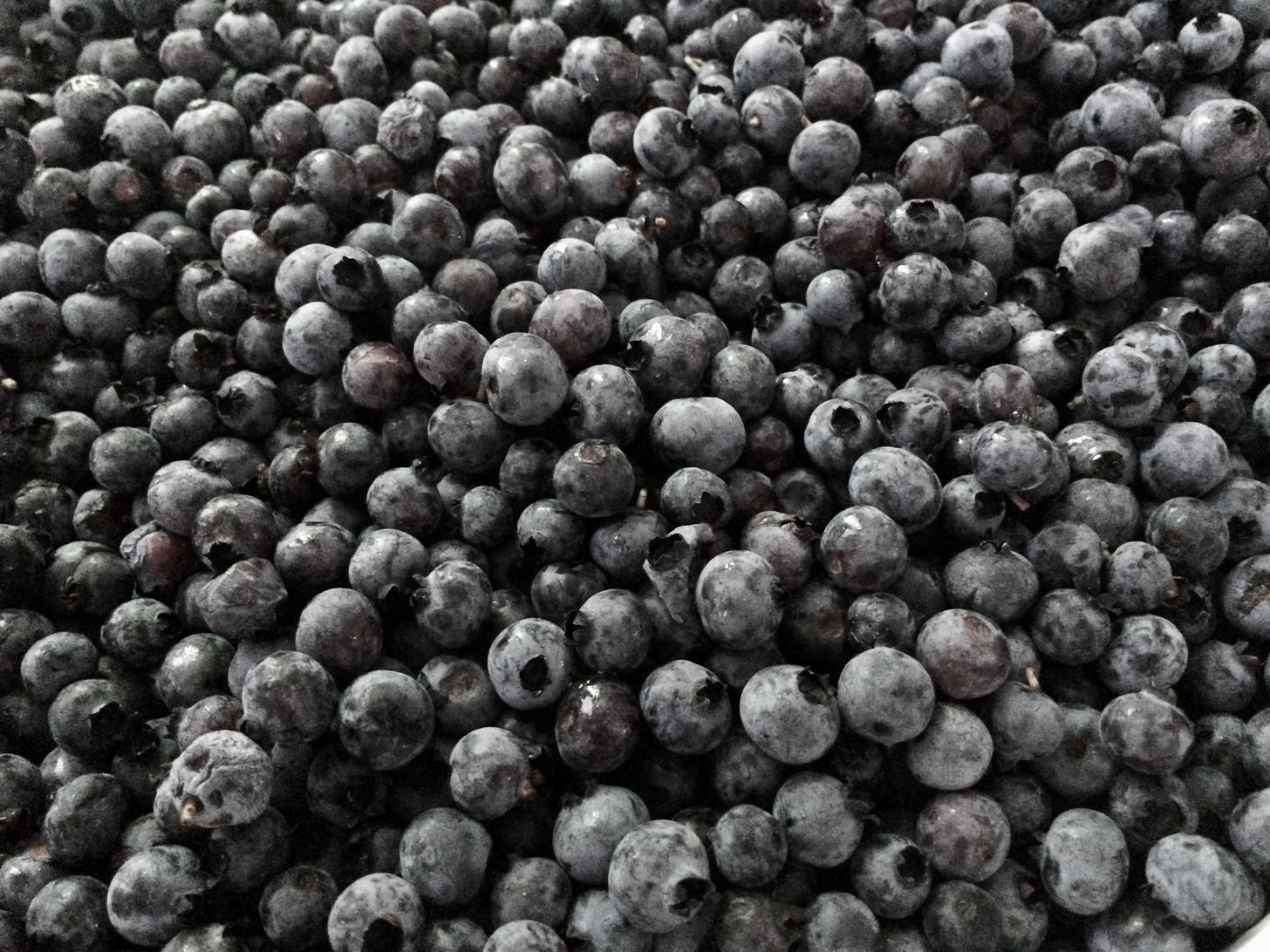
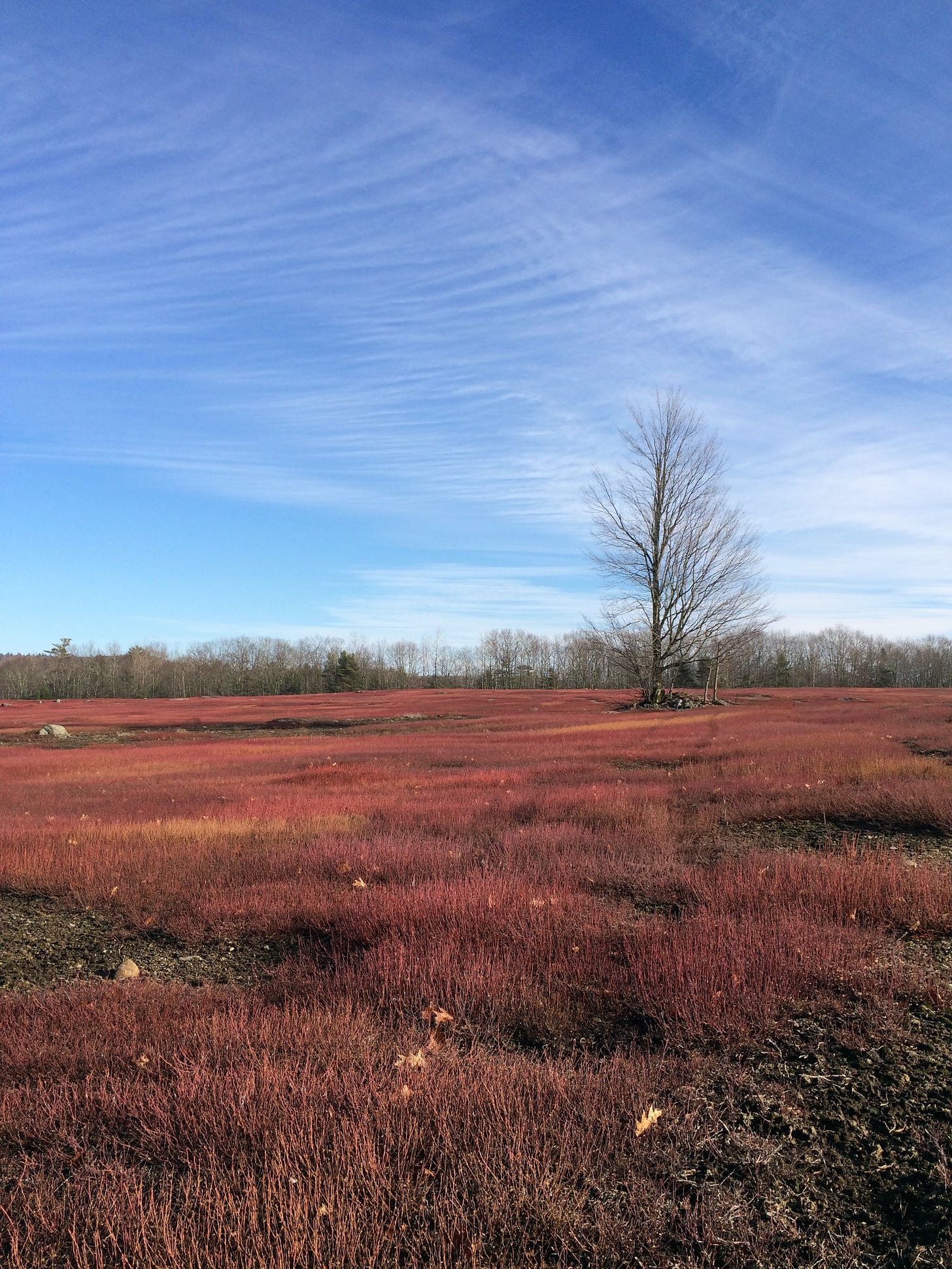
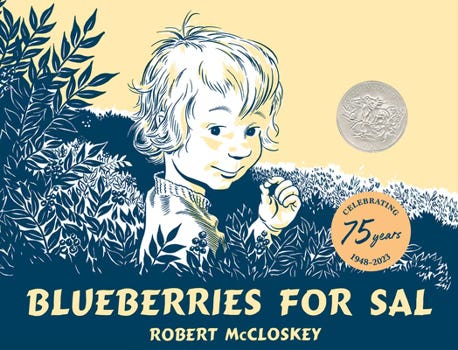
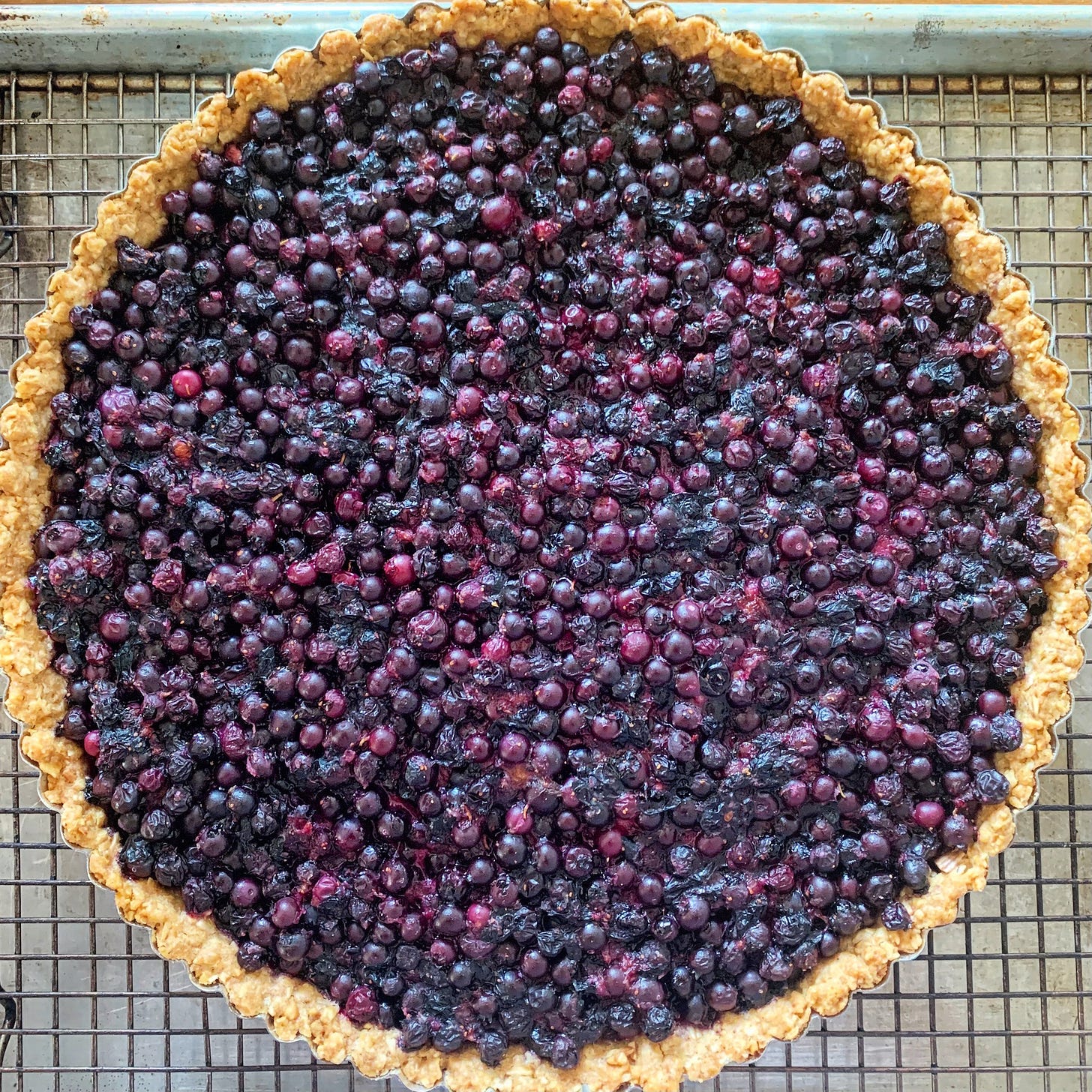
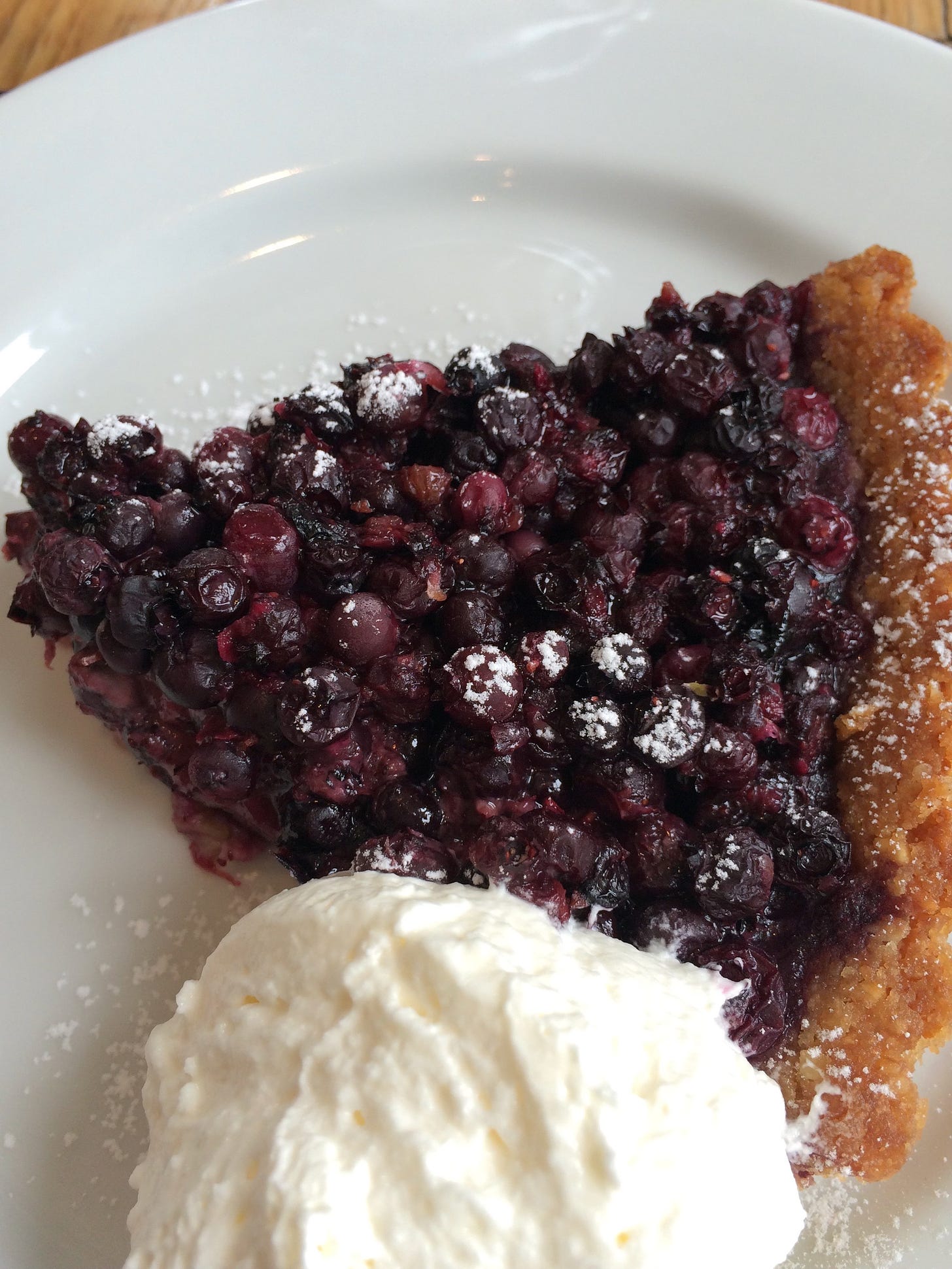
Perfect! And perfect timing. At the moment I have two guests who are first-time visitors to Maine. Many thanks.
Wild blueberries, taller than yours but olso so small and ripening in squence, also prolific where I lived in Wales, particularly along the Yswyth valley but also pickable from an open car window when driving along the steep-banked lane that led to the house. Some years the grandchildren gathered enough for a dozen jars of jam. So glad Arabella is back! Memories are made of this.